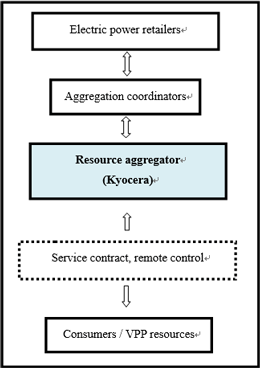This news release is intended for media purposes, and is current of the date of publication. Information is subject to change without notice.
KYOCERA to Participate in Japan's Virtual Power Plant Project to Improve Energy Management
New program tests remote management of changing consumer energy demands, aims to find best use of surplus electricity before end of Feed-In-Tariff in 2019
June 19, 2018
Kyocera Corporation (President: Hideo Tanimoto) announced that it has been registered with the Sustainable open Innovation Initiative (SII) as a resource aggregator*1 for a new program to help control energy resources among Japanese consumers. This latest test project runs until February 2019, plans to expand the coverage area to Tohoku and Hokkaido and is designed to test the flexible response to changing energy supply and demand. Part of a larger program to test a Virtual Power Plant (VPP) utilizing consumer renewable energy resources, Kyocera has been involved in the government project implemented by Japan's Ministry of Economy, Trade and Industry (METI) since 2014 with the goal of realizing a low-carbon society with low-cost, non-fossil fuel energy that does not produce CO2. Japan seeks to have renewable sources account for 22-24 percent of all electrical power generation by 2030.Background and Purpose
Since the Great East Japan Earthquake of March 2011, the country has been dedicated to developing a stable supply of renewable energy and promoting energy efficiency. Consequently, a VPP capable of remotely controlling and integrating distributed power resources including storage batteries and renewable power generation facilities is in high demand. By using a highly accurate energy management system (EMS), the VPP is expected to function as an adjustable supply source of energy. Project participants aim to establish a system that optimizes the energy supply and demand through remote management.
Overview of VPP Test Project
Using Kyocera's Home Energy Management System (HEMS) technology, the company will remotely control energy resources from the storage batteries provided by Kyocera for each contracted household. Energy from the storage batteries will be managed by the company's POM SYSTEM®, a comprehensive energy control system that manages energy-related equipment to reduce the amount of electricity purchased, reducing waste.
The VPP test project is being conducted in cooperation with The Kansai Electric Power Co., Inc., ENERES Co., Ltd., KDDI Corporation and Tokyo Electric Power Company (TEPCO) Group, which serve as aggregation coordinators integrating multiple resource aggregators and assuming a virtual power trading market. In addition to last year's testing areas, the new test area is planned to expand to Hokkaido, the northernmost of the four main islands, and Tohoku, the northern part of Japan's main island of Honshu. By expanding the project and connecting more consumers, the participants will be able to examine potential technical and institutional issues in hardware and software.
| As a resource aggregator and using the company's POM SYSTEM® to control energy demands, Kyocera will bind distributed energy resources and generate electric power sources*2 that can be used by electric power retailers. The system is designed to respond with controls promptly within 15 minutes or five minutes of a major signal of demand response*3. Further, as a part of the demand testing, one of the tertiary power adjustment capacity tests*4 verifies if the VPP can respond to the ever-changing electricity demand signals which will be examined every 15 minutes based on real-operation scenarios that may require further speedy control changes. In response to the upcoming winding down of the Feed-in-Tariff (FIT) in 2019 in Japan, the company will examine the best use of surplus electricity, which is expected to increase, while addressing the challenge of stabilizing the energy distribution system. |
 Schematic of Japan's VPP test project |
In 2014, Kyocera participated in an earlier phase of this project with METI and the Institute of Applied Energy (IAE) where participants established automated demand response (ADR) systems with aggregators and a highly accurate demand response system in anticipation of the “negawatt” power exchange market. In 2016, Kyocera participated in a VPP test project using its own storage batteries and IoT technologies as well as the ADR system.
Through the expertise gained from the various VPP test projects to date and Kyocera's innovative products such as its solar power generating systems and storage batteries, the company aims to establish a group control system of distributed power resources with an ADR system capable of immediately responding to signal changes. In addition, the company will focus on developing technology and storage batteries capable of responding to real-time markets using new methods of electricity transactions.
*1 Operator directly having a contract for VPP service with consumers
*2 Electric power sources preliminarily possessed by general energy transmission service providers to maintain supply-and-demand balance
*3 Energy saving action to promptly reduce electricity consumption of consumers
*4 One of the common menus of the VPP project for the fiscal year ending 2019. The menus are classified into four categories depending on with or without demand signal changes and reaction times.
“POM SYSTEM” is a registered trademark of Kyocera Corporation.